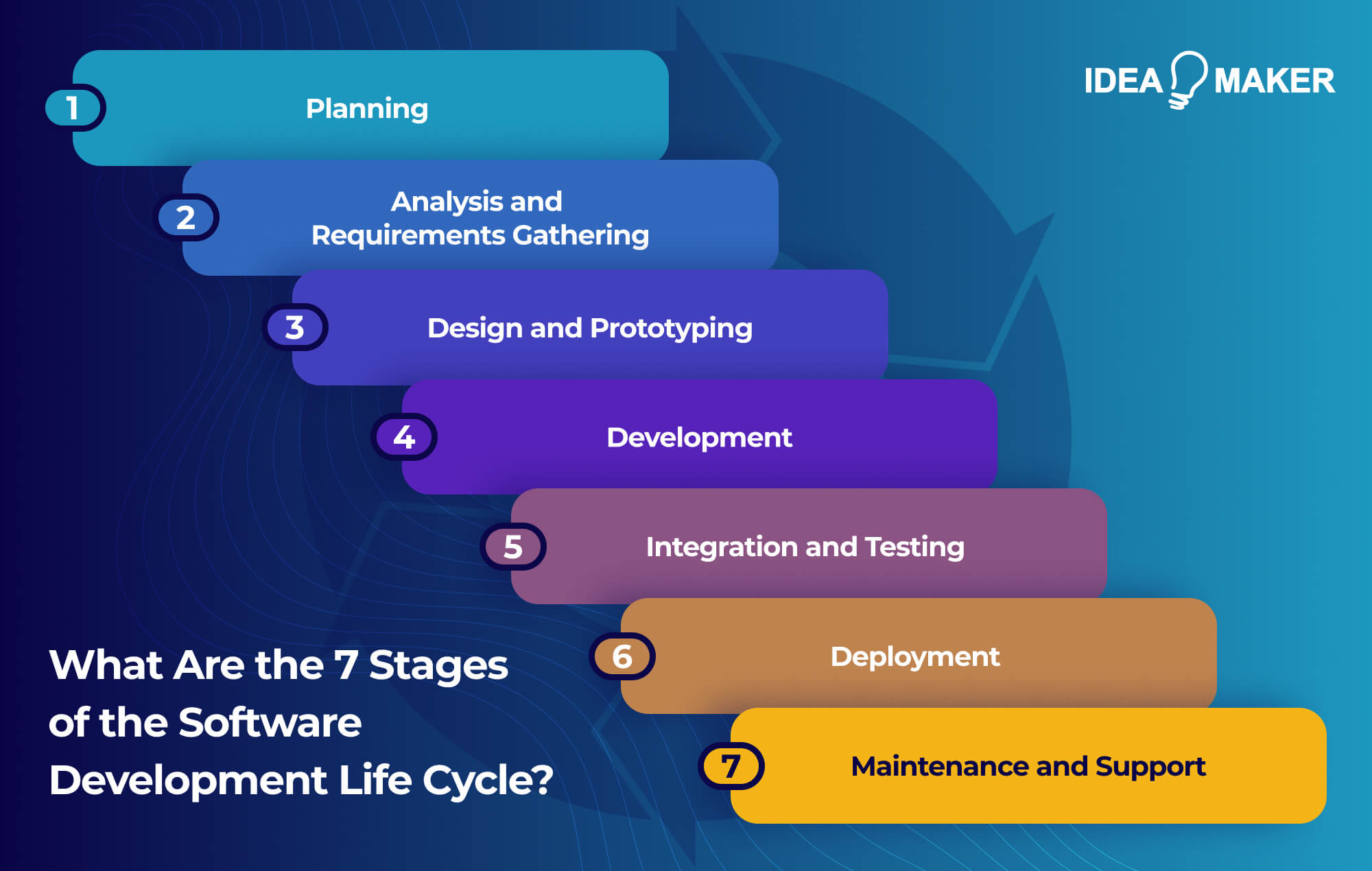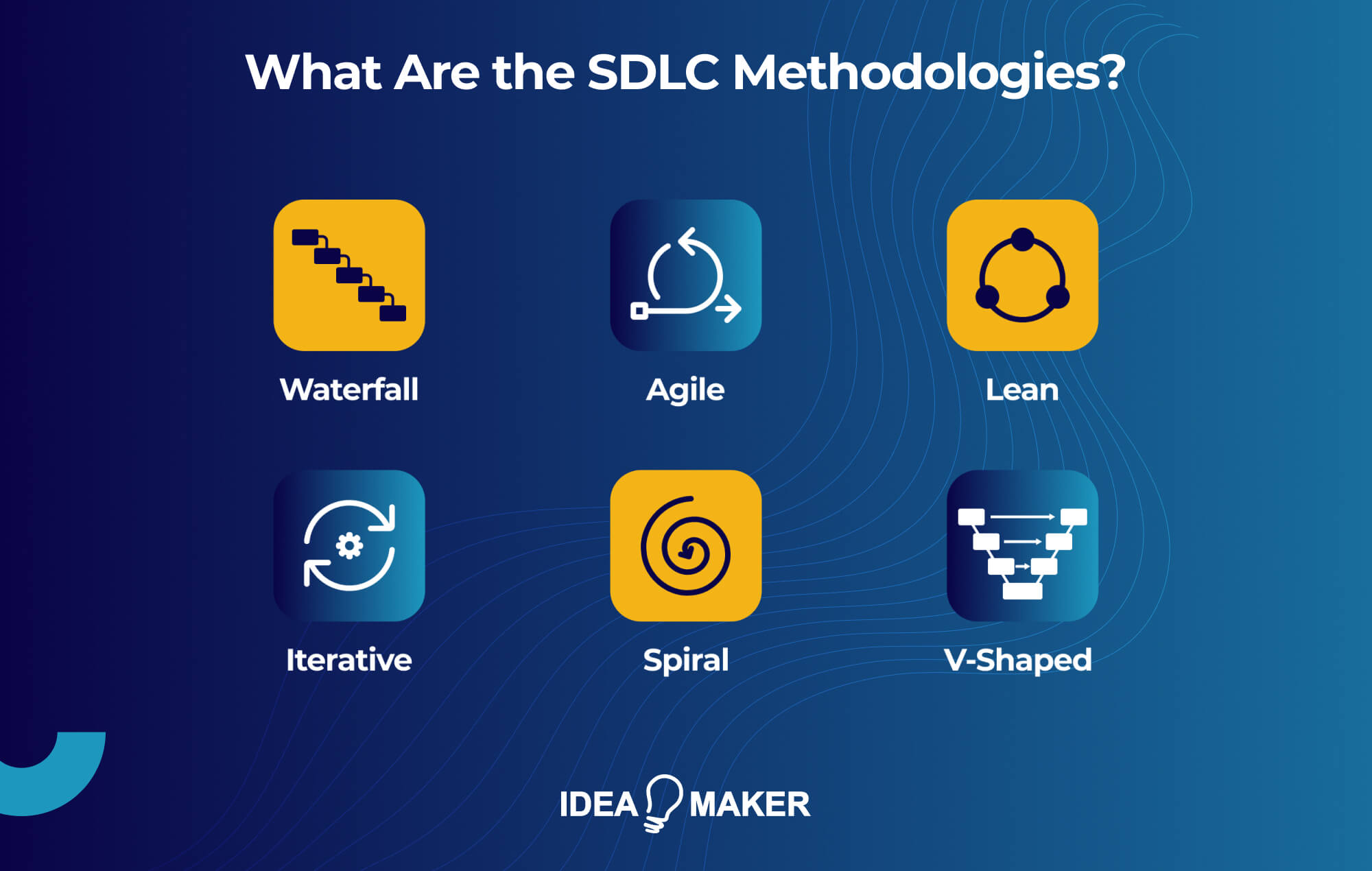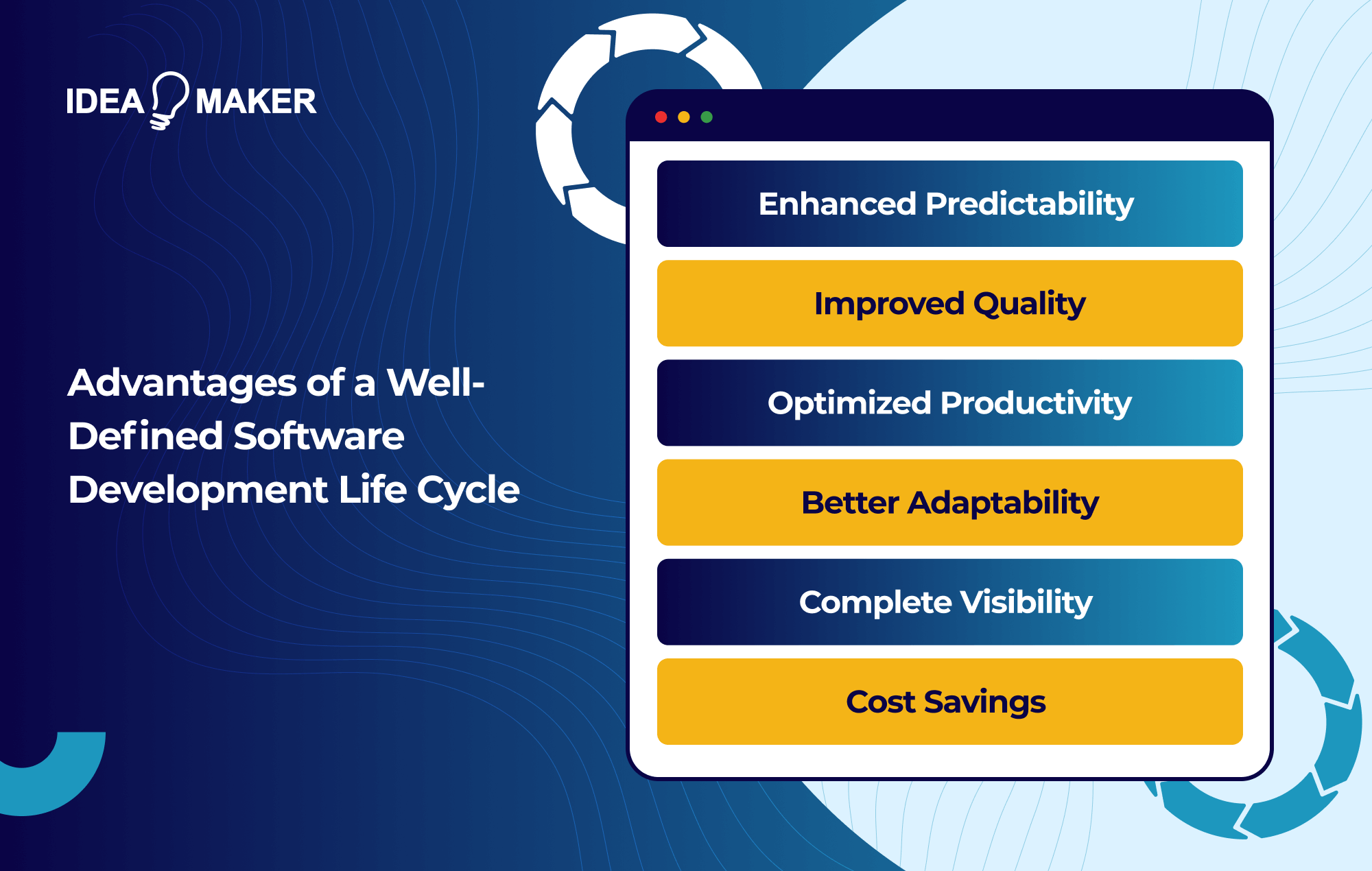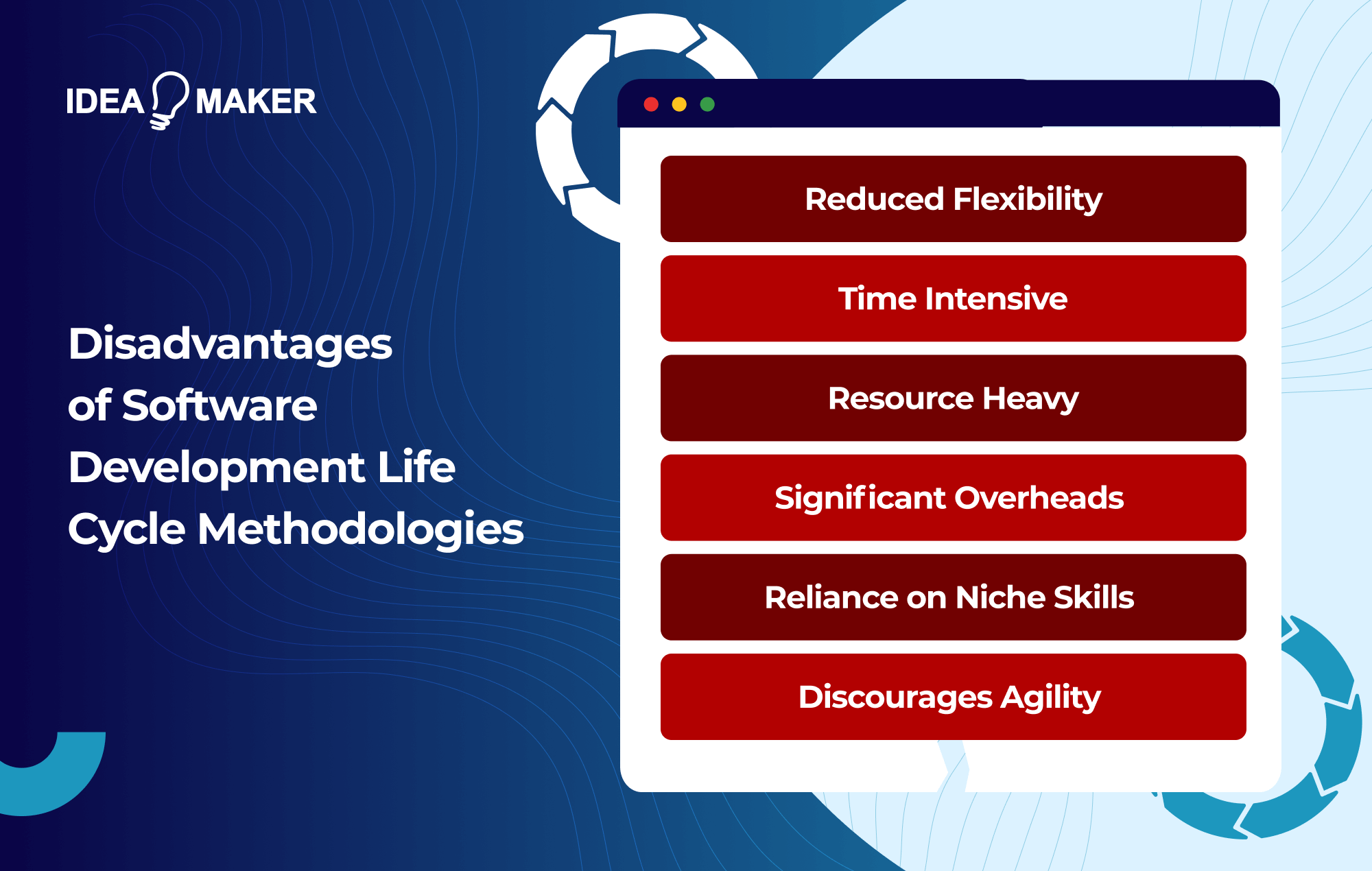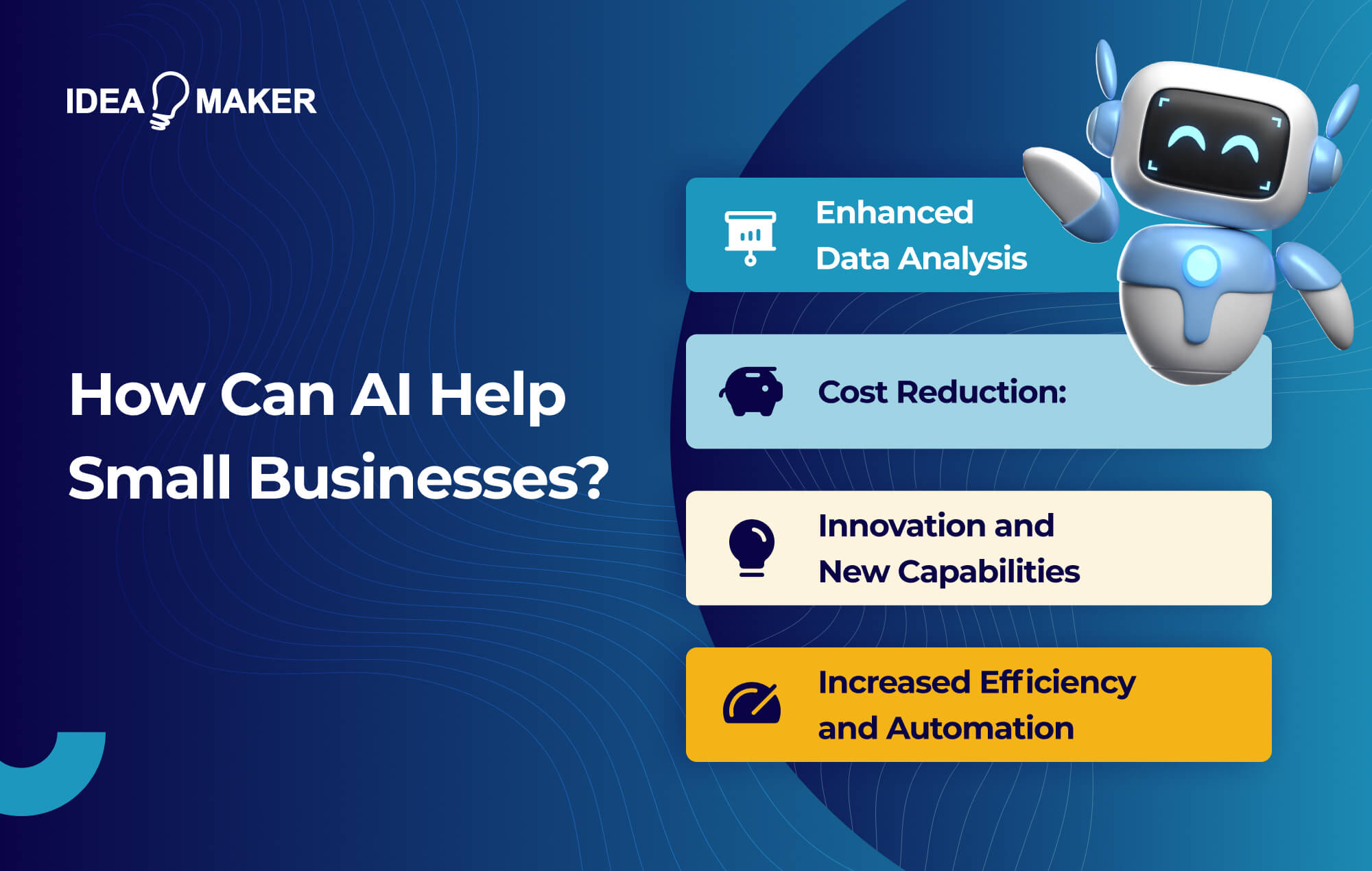Table of Contents
The software application development process has become increasingly complex over the years with the emergence of new methodologies, tools, and innovations. However, even with the changing landscape, the need for a well-defined software development life cycle (SDLC) remains critical to ensure high-quality solutions are built efficiently.
Whether you are managing in-house development or outsourcing software solutions, understanding SDLC best practices is the key to unlocking streamlined collaboration with IT teams and third-party vendors. This is because, by setting clear deliverables for each development phase, you can more effectively meet project requirements and user expectations.
Software projects without a proper SDLC framework, on the other hand, often risk delays, feature deficiencies, cost overruns, and poor application performance. Fortunately, Idea Maker is here to help you navigate all aspects of the software development life cycle.
From popular methodologies to the different development stages, this article will guide you through everything you need to know about the SDLC, so you can confidently select the right framework for your next project. Keep reading to learn more.
What Is the Software Development Life Cycle?
The software development life cycle (SDLC) refers to the end-to-end process of building, deploying, and maintaining a high-quality software application or digital product. It provides a framework for seamless development with clear deliverables for each phase.
Essentially, SDLC methodology breaks down the complex software creation process into distinct stages, from the planning, analysis, and scoping of the project to designing, developing, testing, and deploying. Then, after the application has been launched, maintenance and support activities continue to improve its capabilities and user experience.
These structured phases allow for predictable progress tracking, as teams can identify and resolve issues earlier in the development process. Not only does this help reduce the cost of fixes, it also enables easier collaboration with stakeholders within and outside the organization.
While the core components that characterize any SDLC remain the same, there are many different software development approaches that firms can choose from, including the waterfall, agile, iterative, and spiral methodologies. Selecting the best SDLC model for your project needs ultimately ensures the software is built and delivered to match the original business requirements.
Importance of SDLC
Having a defined SDLC methodology is crucial for meeting digital transformation goals and delivering large-scale software projects. In fact, according to BCG research, nearly 70% of digital transformation initiatives fall short of expectations. Simply put, without a streamlined development process, organizations often struggle to build applications that drive real business impact.
SDLC frameworks, however, provide the engineering discipline needed to translate strategic objectives into functioning software by breaking down amorphous digital goals into executable features delivered in phased releases. This prevents disconnects between business leaders and technical teams, enabling easier collaboration and ensuring transparency.
A well-defined SDLC also helps development teams set clear expectations and accurately estimate the effort and resources required for a project, which generally leads to cost savings. Additionally, because each phase delivers measurable outputs, teams can track project progress much more efficiently and better facilitate course correction when needed.
What Are the 7 Stages of the Software Development Life Cycle?
The software development life cycle comprises seven key phases that cover the entire journey, from initial planning to post-release support. So, to help you gain a better understanding of what to expect during your project’s development, let’s briefly walk through the process together, highlighting the main purpose of each stage.
-
Planning
In this preliminary stage, project scope and goals are defined by factoring in costs, resources, and timelines, justifying the software investment. Once the project has been deemed feasible, teams then begin evaluating technology options and outlining user needs. The project roadmap, risk management plan, and resource blueprint are also developed to ensure a streamlined development process.
-
Analysis and Requirements Gathering
After the planning phase, developers shift their focus to the project’s requirements, engaging business and technical stakeholders through workshops. Detailed functional and non-functional requirements are then gathered, analyzed, documented, and prioritized based on user feedback. Both user workflows and system processes are also charted out in this crucial phase.
-
Design and Prototyping
With requirements established, it’s now time to move on to the design phase. This involves designing the structural and visual aspects of the software, including its architecture, system integrations, databases, APIs, and other technical components based on the finalized specifications. Graphic elements, interface layouts, style guides, and responsive frameworks tailored for target user devices are also conceptualized by UI/UX designers.
Detailed visual comps and interactive prototypes are then developed, enabling product owners and end users to evaluate the application ergonomics and identify any usability issues. Feedback at this phase prevents costly rework, allowing for quick iterations.
-
Development
In the development phase, engineers build the actual software application. For this, coders write programming logic and instructions as source code files using appropriate programming languages, such as Java, JavaScript or C++. Relevant frameworks like .NET and React may also be leveraged to accelerate the coding process.
As new code components get developed, unit tests are written in parallel to validate each function and isolate bugs, while code reviews run iteratively to improve quality through peer feedback. Refactoring, performance optimization, and integrating updates through version control systems like Git happen continually, as well.
-
Integration and Testing
Once the application has been built, software modules are then integrated with libraries, tools, and organizational systems to test as a complete solution. This phase involves conducting a variety of quality assurance tests, focusing on performance, security, UI/UX, and accessibility across devices and browsers. Based on user feedback, additional development cycles may also be required to ensure the solution meets all functional, security, and compliance standards before deployment sign-off.
-
Deployment
In the deployment phase, the tested software application is released from controlled environments into production infrastructure accessed by end users. This key process consists of migrating data from legacy systems, configuring interfaces with integrated enterprise systems, and setting up servers, storage, databases, firewalls, VPNs, SSL certificates, and other security controls as designed.
Additionally, failover systems and backup processes are established, while comprehensive deployment runbooks are executed to install the application, configure settings, verify services, and validate accessibility. A capacity plan will also be created to ensure adequate performance headroom for current and projected usage spikes.
Then, after smoothly transitioning end users to the new system, roll-back contingency plans remain on standby for mitigating any issues. Maintenance processes managed by the operations team now keep the software updated and available through its productive life cycle.
-
Maintenance and Support
Once the software application is deployed, the post-implementation maintenance phase sustains its long-term adoption through ongoing support, incremental enhancements, timely fixes and periodic upgrades. Not only are bugs reported in production get fixed based on severity through patches and version upgrades, technology infrastructure, such as servers, databases, and networks, are also kept updated to maintain interoperability as dependent systems change. On top of this, optimizations and security hardening continue iteratively responding to evolving threats, ensuring a safe and seamless user experience throughout the solution’s life cycle.
What Are the SDLC Methodologies?
Although the core software development life cycle provides the blueprint for building applications through systematic stages, there are multiple development methodologies within this standard framework. The right model for your project will depend on various factors, such as team size, rate of change, and time to market needs. So, to help you decide the best approach to take, let’s take a look at some of the most popular SDLC methodologies.
-
Waterfall
The traditional sequential waterfall methodology entails rigorous requirements, design, staged development, testing and infrastructure deployment phases executed irreversibly. With stage gates after each phase, this method ensures the discipline needed for large business applications built over a number of years. However, its lack of flexibility due to frozen requirements and minimal user involvement until testing often results in late issue discovery and change management challenges.
-
Agile
Agile delivers working software every two to four weeks through iterative cycles called sprints. Driven by customer priorities, self-organizing teams rapidly incorporate feedback to build solutions incrementally, encouraging swift responses to change. However, large-scale agile adoption across distributed teams requires thorough documentation with model-based development and DevOps automation to ensure rigor for enterprise systems.
-
Lean
Lean software development focuses on optimizing cycle times and preventing wasteful activities that delay the delivery of end-user value. By leveraging development approaches like the minimum viable product (MVP), it concentrates engineering effort only on innovative features customers want through small but regular capability batches. These just-in-time requirements, however, require strong product ownership to prevent scope creep due to changing priorities that often characterize lean processes.
-
Iterative
The iterative approach involves sequential cycles of requirements gathering, system design, build, and test phases until all features are complete. Each iteration aims to enhance functionality and incorporate user feedback from previous rounds, allowing for evolving scope. However, the deliberate cycles make it slower than agile, and multiple cycles may be needed for enterprise-grade quality.
-
Spiral
The spiral model combines both sequential waterfall gates and iterative prototyping cycles driven by risk analysis. Incremental prototype releases help validate concepts and identify issues early, enabling a high level of flexibility. However, progression across linear SDLC stages makes it more documentation-intensive and costlier than pure iterative methods.
-
V-Shaped
This highly-structured methodology focuses on early test planning and validation cycles for requirements before large-scale development commences. Rigorous reviews, code inspections, and quality audits then run alongside coding phases, reinforcing validation. Traceability between phases enhances reliability but makes incorporating user-driven changes more difficult once development starts.
Advantages of a Well-Defined Software Development Life Cycle
As we touched on earlier, having a clearly defined SDLC framework is crucial to the overall success of your project. From streamlined workflows to cost savings, here are the top benefits you can enjoy when implementing a well-defined SDLC methodology.
Enhanced Predictability
The milestones and deliverables provide a predictable roadmap to complete software projects as per schedule. Well-defined SDLCs with clear requirements and design freeze gates also lead to more accurate effort estimation, as variability reduces with specialization. This prevents uncontrolled budget and timeline overruns, resulting in a higher return on investment.
Improved Quality
The rigorous requirements analysis, incremental code reviews, test-driven development protocols and QA governance instituted by SDLC results in robust, resilient and high-performing software. The structured system testing and user acceptance validation at each stage also minimizes defective production releases, ensuring stability, speed, and the intended user experience.
Optimized Productivity
Standardized SDLC terminology, streamlined workflows and specialized cross-functional teams eliminate communication gaps, enabling easier collaboration. Clear accountability through stage owners further improves productivity, as tasks get distributed optimally to specialists. Code reuse and utilizing shared work products like libraries through version control also eliminates redundant and conflicting efforts.
Better Adaptability
Modern iterative SDLC methodologies allow for the dynamic incorporation of changing user needs late in the application life cycle through loose coupling and configurable architectures. Shorter release cycles–sometimes within weeks or days–means software can adapt much quicker to market changes. Cross-functional change control boards also enable easier approval of requirement changes.
Complete Visibility
Granular dashboards and performance monitoring, such as velocity and progress tracking, provides end-to-end visibility across SDLC phases. Dive capability into key metrics, for example, identifies inefficiencies to address proactively through data-backed decisions on resource or infrastructure allocation. Test automation also helps to provide quality insights.
Cost Savings
Higher quality software developed through rigorous SDLC protocols faces fewer disruptive production issues, leading to significant cost savings from reduced downtime. Well-defined development processes also prevent wasteful efforts and help conserve expensive specialized engineering resources. Consequently, by eliminating redundant process steps, productivity can greatly improve, as well.
Disadvantages of Software Development Life Cycle Methodologies
While implementing a standardized SDLC framework brings process efficiency, the associated overheads and constraints do require careful evaluation. However, understanding these disadvantages prior to your project’s development will enable you to mitigate any potential risks and challenges.
Reduced Flexibility
Rigid sequential models like waterfall mandate freezing requirements early and lack flexibility to incorporate changes post-design. Any additions later causes major rework across documentation, code, and tests, translating to overruns, project delays, and higher development costs.
Time Intensive
Meticulous requirements gathering through customer workshops, extensive documentation across phases, cross-functional reviews, and sign-offs generally make SDLC methodologies slower. For example, compiling hundreds of pages of functional and technical specifications consumes up precious build time, delaying software delivery.
Resource Heavy
SDLC stages need a wide range of specialized skills, such as business analysts, software/security architects, developers, quality assurance engineers, release managers, and production engineers. Unfortunately, most small firms lack full-time availability of niche subject matter experts that fit within budgets. Even larger teams find specialized skills tough to acquire and retain for distributed models, causing various workflow issues.
Significant Overheads
Comprehensive SDLC protocols require building substantial infrastructure like code repositories, developer IDEs, automation tools, and project tracking systems that involve capital and operational commitment. Integrations with other organizational systems, such as human resource management systems, adds even more complexity. As a result, maintaining multiple isolated environments for testing requires dedicated teams, driving significant overheads.
Reliance on Niche Skills
Losing key resources with niche SDLC expertise like technical architects, database designers, and test automation specialists midway generally leads to unplanned delays and skill gaps. Distributed agile teams with members across time zones makes retention of niche talent all the more challenging, and hiring replacements can be time-consuming. This reliance on niche skills ultimately impacts project delivery, especially in domains facing skill shortages.
Discourages Agility
While modern iterative SDLCs do allow changes, frequent feature additions or requirement modifications post-development introduces governance challenges. Such late-stage changes require reworking tests, configurations, and release plans, causing cost and schedule overruns.
Overcoming SDLC Challenges
To overcome the difficulties outlined above, organizations must pragmatically balance SDLC discipline versus agility based on project goals. For sequential models, flexibility can be built in through change control boards, whereas just-enough documentation and lightweight tools serve best for faster-release models like agile. Staffing challenges can also be addressed by training resources across stages.
Effective SDLC Practices From Idea Maker
With vast expertise across the entire software development life cycle, the experts at Idea Maker are committed to leveraging the latest innovations and approaches to ensure a streamlined and collaborative development process. Our team can thoroughly assess your current development processes to identify opportunities to implement best practices and tailor your SDLC methodology to your unique needs. Schedule a free consultation today to learn more about how our SDLC knowledge can help you meet your digital transformation goals – on-time and on-budget.

